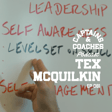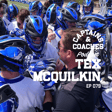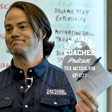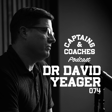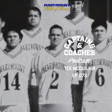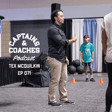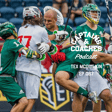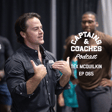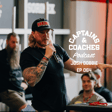Introduction and Podcast Overview
00:00:09
Speaker
To use the Navy SEAL phrase, no one rises to the occasion. You fall to the level of your training. My name is Tex McCulk, and I am the host of the Captains and Coaches podcast. And today
Incident Overview: Rhabdomyolysis at Tufts University
00:00:21
Speaker
we'll be discussing a topic that is near and dear to my heart as a former Division III lacrosse player, coach, and strength and conditioning professional. Last week at Tufts University Division III program in Boston,
00:00:34
Speaker
50 lacrosse players participated in a captain's workout practice. 12 of those individuals got rhabdomaleosis. At the time of this recording, five of the 12 remain hospitalized. This is a very
What is Rhabdomyolysis?
00:00:50
Speaker
serious issue that will impact the lacrosse community and the collegiate strengthening edition and community, which then trickles down into high schools.
00:01:00
Speaker
Rabdo is when muscle tissue is so stressed that it breaks itself down since proteins and electrolytes into the bloodstream through the kidneys and you're urinating out components of your muscle. This is a
Preventing Future Incidents: Strength and Conditioning at Division III
00:01:17
Speaker
extremely life-threatening issue, could lead to kidney failure, seizures, it's bad news. This podcast, we're going to break down the strength and conditioning at the Division III level speaking directly to the coaches involved from my experience and then breaking down conditioning guidelines for sport coaches to understand so we cannot let this happen again. Here's the situation. This
The Workout Incident: Details and NCAA Rules
00:01:45
Speaker
is what we know. This was a 45-minute workout led on campus by a volunteer, not a member of the lacrosse sport staff or the Tufts strength and conditioning staff.
00:01:57
Speaker
The volunteer was a graduate of Tufts and successfully completed the selection process for the Navy Seals called BUDS, Basic Underwater Demolition Seal Training, which only about 25 to 35% of the people that even try make it through. That's an accomplishment as an athlete. Doesn't make you a good coach. There's a current investigation through the university and there are a lot of unknowns.
00:02:22
Speaker
For Division III, captain's practices are against the rules and it is highly illegal for a coach to observe these if they do happen. So part of the sport coach, if they observe, crosses a spring sport that gets 16 practices during the fall. If a sport coach observes this, it docks them one of those practices during the fall to prepare for the spring season.
00:02:49
Speaker
There's a lot with this situation that could unfold that could negatively affect NCAA rules, strength and conditioning at the Division III level, maybe up and especially down.
Tex's Background and Qualifications
00:03:00
Speaker
All these rules aim and sometimes trickle down into high schools and then potentially somebody's job. So we're going to explore a lot of the components here so we can prevent this from ever happening again.
00:03:12
Speaker
I want to qualify myself before getting into some of the components of this conversation. So like I mentioned at the top of the podcast, I'm a division three lacrosse player. I was a four-year starter and three-year captain for Marymount University in Arlington, Virginia. That also was my first coaching opportunity as a graduate assistant coach. I was a sport coach with the defense and then took on the conditioning responsibilities at practice for my squad.
00:03:40
Speaker
From Marymount University, three years jumped to Georgetown University Division I to work with men's and women's lacrosse amongst other sports, but the passion stood with lacrosse. I've been a CSCS, Certified Strength and Condition Specialist since 2012, and the past two certification cycles been distinguished through my presentations at the national level. A lot of those are on YouTube. Check them out.
00:04:06
Speaker
So I also had an article published on conditioning tests and conditioning during practice that was published by the NSCA in 2015. If you want a copy of that, ping me on Instagram or drop a note in the comments. I'll happily share that. I worked with John Wellborn teaching over a hundred traveling seminars.
00:04:26
Speaker
John was contracted by CrossFit to teach a sports-specific application of CrossFit to CrossFit coaches. CrossFit in the world of strength and conditioning, it takes rhabdomaleosis as a badge of honor. So we did our damnedest to then educate on sports performance. And if you got athletes into your gym, here's how to empower their performance, to use the line from John's company Power Athletes.
00:04:55
Speaker
So we've attacked this RABDO conversation in a sports performance perspective all over the world from 2012 to 2017. We've also worked with John to lead seminars for naval special warfare so understand the demands of that job.
00:05:14
Speaker
preparing for buds and all the way to the tip of the spear for that population. And I still coach high school lacrosse. I love the game. I'm always going to stay connected to it through the sport, coaching the sport, and then using my knowledge and experience as a strength and conditioning specialist to help the teams that I'm working with.
Strength and Conditioning Support Across Division III
00:05:34
Speaker
All right, so now we're going to deep dive some of the topics presented earlier in strength and conditioning at the Division III level. Some schools at this level have a full strength and conditioning staff. This is what Tufts has. They have a beautiful weight room. Sorenex, it's an awesome facility. Pictures are all over online. Go ahead and check them out.
00:05:54
Speaker
That staff did not run this workout. So we need to be clear on that. I don't want any heads to roll from their department. Some schools at Division 3 have one strength and conditioning coach for all 20 plus sports.
00:06:10
Speaker
They run those coaches into the ground and often don't appreciate them. So the individuals that are leading all those teams, I feel for you. You're in the grind. You get an awesome opportunity to take those athletes where they can't take themselves and protect them from themselves. Most schools at this level do not have a strength and conditioning coach.
00:06:31
Speaker
The responsibilities for sports performance fall on the low man of the totem pole, who is the youngest assistant coach, who is newest to this. And what does that coach do? They lean into their experience as a collegiate athlete themselves, or the current workouts that they're doing as four year plus athletes. So applying their workouts to a different population that hasn't had their experience,
00:06:58
Speaker
not the best suit.
Common Coaching Mistakes and Mental Toughness
00:07:02
Speaker
that's a problem that exists in this game when coach, sport coaches, uncertified, not experienced, take on those responsibilities. And that's an example of what we have here, an enthusiastic individual, uncertified, but an awesome athlete that then took charge of the squad here.
00:07:21
Speaker
that's a common first year coach mistake where you are a passionate individual. You love the sport. You love the team. So you want to step up and hold them to your standard. You're willing to sacrifice and be a coach for your team. And then you start to resent them for not wanting it as much as you do. This is a coaching paradox where your athletes don't want it as much as you. It's not their job.
00:07:47
Speaker
There's going to be individuals that pour and buy in. Those become the captains. So don't resent the individuals that are not as bought in as you. So you're using what you felt in your training experience and then giving it to another individual. You've got no grasp of volume and intensity that first year. It takes a lot of mistakes for you to understand what kind of damage is being done and then the bell curve that exists on a team.
00:08:15
Speaker
There's lots of different positions. There's lots of different individuals, lots of different training ages. You got freshmen, two seniors. In the sport all across, strength and conditioning is not connected to it as it is with football.
00:08:30
Speaker
So if you're coaching freshmen, they are coming to you and they did not play football. There's a high likelihood that they have never touched a barbell or experienced any formal training. During the summers, instead of doing off-season weights and sprints with the football team, they were playing travel ball and only lacrosse.
00:08:49
Speaker
So taking those freshmen individuals and then throwing them in with the two, three, four year seniors, that's the wrong training age and that's when potential issues occur. You're also applying hard workouts that have a purpose. You're applying them because you did them and you felt they were tough. You're using mental toughness as the purpose and that's very vague. It's not good enough.
00:09:16
Speaker
you need specific measurable successes when it comes to strength and conditioning.
Leadership Roles of Captains
00:09:23
Speaker
If you can measure it, you can manage it. But if we're going for perceived effort, intensity, then that's too vague, especially when it comes to something as mental toughness. All right, so that there's an aspect of the Division III strength and conditioning. This podcast certainly will explore that. There's a lot of coaches doing amazing things at this level.
00:09:46
Speaker
All right, now we're going to speak directly to the coaches leading off with the head coach. You got to own it. You're coming off back-to-back national championship appearances, bringing home the championship last season. You know what you're doing in the world of lacrosse, no doubt. And we don't know the conversation that occurred. If this was greenlit with this trainer for the session, we don't know that.
00:10:13
Speaker
you have a strength and conditioning staff. I imagine they handed out packets for the summer following the national championship, so there's examples of workouts that the team can pull from.
00:10:26
Speaker
that they are regulated, it's volume, regulated intensity and a prescription from the staff that our team captains could have leaned into during the captain's practice. I know those are not part of the NCAA rules, but if leaders want to lead,
00:10:45
Speaker
That's on them to take charge. It's imperative though, you don't give them specific directions, but then encourage them to look find where there are resources to look for if they want to take charge of their team.
00:11:01
Speaker
So lean towards your strength and conditioning packets and staff that exist there. More than likely, you live in beautiful Boston. There is local runs within the neighborhood that have been established with the team for decades. This is just one of those Division III things that exist with lacrosse teams. There are certain runs within all the neighborhoods because the towns are in, the teams are in such fun towns. So encourage them to go on those local runs. This is important for captains because they're practicing their leadership. There's not an individual that steps in and leads and guides them. They take on the responsibility of finding the guys on campus, messaging the team, making sure everybody shows up on time and remembers that we have a fun run
00:11:53
Speaker
the next day. They make sure that we're warmed up and good to go and get the guys initiated. All these are small steps and reps that are going to pay off for you when you do start your fall practices, when you do get late into the season, and then people know who the leaders are, who's good at organizing, and they can gain that trust.
00:12:14
Speaker
There's also an opportunity for the teams that just scrimmage or do one-on-ones or have the seniors grab the upperclassmen, grab the lowerclassmen, and just throw around. Do one-on-ones. Play a two-man game. So there is an opportunity. There are fields that exist that are unlocked. I'm not saying tell them to go do this, but again, encourage leaders to lead.
00:12:43
Speaker
don't observe what goes on during those practices and times, but we want to see those upperclassmen establishing the intensity in 10 cities of a national championship team.
Highlighting Successful Programs
00:12:55
Speaker
So that way, when they do show up fall practice number one, they've already got a taste of what it takes to win from the experienced kids on the team. The next few months are going to be interesting. Usually it's the strength and conditioning coach who takes the fall for something like this.
00:13:13
Speaker
So there are some coaches out there that are doing amazing jobs. Shout out, Matt Nye in Salisbury University. You do a great job at the Division III level across all sports. Pains me to say that as Salisbury was in my conference and kicked my butt numerous times. And that that relationship that Matt has with each of the sport coaches and all the athletes is a great example for programs out there. The relationship that I had with the Georgetown University, the first year making that jump from D3 to D1, it was also the first year that Coach Kevin Warren took over for coaching Georgetown University. He's still there, rocking an awesome program, top five program in the country.
00:13:57
Speaker
When he got there, it was not a top five program. He leaned in to the strength and conditioning staff, which was Coach Sean Foster and myself. Coach Foster is still at G-town working with the soccer team, doing an amazing job. So, Warren wanted a culture change within that. So, he spoke to us and established the expectations and we worked within the bounds. We changed the we changed the strength and conditioning to early mornings versus the afternoon. That was one thing. So within the bounds, we always had an athletic training team member there at the 6 a.m. runs, but he leaned into us and we took the appropriate things, we took the appropriate steps necessary by programming out progress. We had difficult workouts to begin. If you've ever been to Georgetown in Washington, D.C. or seen the movie The Exorcist,
00:14:53
Speaker
There was this giant path of stairs, and we just repped them. It was a progressive rep load that went up and up and up each week. And waiting at the top of the stairs was yours truly with isometric work. So we weren't doing
Athlete vs. Coach: Different Skill Sets Needed
00:15:10
Speaker
push-ups. We weren't doing jumps. We weren't doing destructive stuff, burpees, or any of those challenging workouts that could lead to to RABDO.
00:15:22
Speaker
We were focused on isometric holds, pillars, dead bugs, side planks, all this different stuff where we had a target of focus, and then it was testing their aptitude during this. Can they maintain a good, tall, pretty posture under the stress and duress? If they went down, it's on to the next rep. At no point was I stepping into MF then. We let the movements do the mind melting during those sessions.
00:15:52
Speaker
And Coach Warren took care of the rest. So awesome job. It was cool to be a part of that during the sidelines in the weight room. I'm grateful for that experience as a young coach taking on the responsibility of scholarship athletes. And I did not take that responsibility lightly. And they're still rocking and rolling. It was cool to be a part of that first team that made it back to the Big East tournament. OK. So now I'm going to speak to the trainer.
00:16:22
Speaker
I'm speaking directly to you, so listen up. I'll quote John Welborn again, quoting Greg Glassman, the founder of CrossFit, you fail at the margins of your experience. Your experience is as an athlete.
00:16:37
Speaker
Potential, successful, you made it to that championship team or you made it at the conference. I don't know if you were a part of the lacrosse program or not, but you did pass butts. That is a feat, a success. It's not easy. Great work. Congratulations. But that does not make you a coach.
00:16:55
Speaker
and I'm not taking anything away from your accomplishments as an athlete, but I need to understand there is a difference just because you accomplish something, it's different when then you need to apply that volume, that intensity, that training to someone else, especially the bell curve that is a team of people returning and then people starting out fresh with the team.
00:17:17
Speaker
I want you to switch hats now. I'm not speaking to athlete. You rock, you're awesome. Thank you for serving our country. But now we're putting on the coach hat. And I'm speaking first to your coaching experience. And I am with you 100% of the way. I will not poo-poo-poo or let you down. If you need guidance, please reach out. None of this is attack, okay?
00:17:45
Speaker
That being said, when I present information here, I encourage you to listen and not get defensive. Not say things like, well, that workout was easy. That shouldn't have happened. That's getting defensive. It was easy for you if you did it, but you also had X amount of years of college experience and most likely trained for that event that you're not factoring and taking into consideration here.
00:18:11
Speaker
So take all this and have some awareness, some situational and self-awareness here for the magnitude of the situation. I understand you meant well, however, you broke the golden rule when it comes to coaching, which is do no harm.
00:18:30
Speaker
Taking responsibility will allow you to analyze the workout and figure out where and why this occurred. Again, 20% of individuals having the same issue or injury, that's got to jump out as the program or the application and the coaching of the workout and the program. All right. So here's questions I want you to start to ask yourself.
00:18:55
Speaker
Was this a workout that you personally have done before? If yes, what were the 10 workouts that led up to you successfully completing this and making it through?
Training Gaps and Warm-Ups
00:19:08
Speaker
What led you to success there?
00:19:11
Speaker
Whether you realize this or not, you prepared and trained for the workout that you applied and gave. It's not the same as it is on paper for you as taking it and writing it down on paper for another individual, especially freshmen coming into this world that have no training experience. It may have been easy for you, Navy SEAL training, right? But then these guys are not you.
00:19:36
Speaker
You have no idea what they did over the summer, whether that was good for their bodies or bad. And you have no idea what they did the weekend before or the night before. stay in that mindset that this workout was easy.
00:19:56
Speaker
Take that breath away. They won the national championship on Memorial Day weekend. What was their summer like? Was it June off? Was it July? Pick the stick back up again. Then August? Oh crap, time's ticking. I need to start running and jogging.
00:20:12
Speaker
to get back in shape, to get back in shape. So we need to understand what the scope of the team did that summer. And this can be done during the warmup. If we're warming them up properly and we're seeing extreme signs of fatigue during our 10-minute dynamic warmup, oh, it's very clear that they didn't do their workout. Here's something I want you to hold on to. Athletes will lie to you. Movement never will.
00:20:39
Speaker
So use that dynamic warmup as the time to not only connect with your athletes, but also read their body language and physiologically what's going on with them. Currently, when they're just getting back to campus before you start your fall off-season training, you're in off-off season. So this is important where we want to focus on bringing the team together not necessarily mind melting them into the ground with a workout.
Flexibility in Workouts and Learning from Mistakes
00:21:09
Speaker
There's a difference between that suffering and then bringing a team together. It's a fine line that you need to establish and walk. So this is why conditioning tests are in place for teams.
00:21:22
Speaker
So coaches can apply the conditioning test and see what their athletes did over the summer or over the winter break. So there's value within that conditioning test is the quick assessment if they're not in position yet to read the body language and the movement and tell through different warm-up drills how much work was done and if the program was followed.
00:21:45
Speaker
So here's what I love to do is sprinkle in new movements in that off-season program. So that way, if they do the reps and the sets, then they gain coordination and experience within those movements. So now when I call upon that movement,
00:22:00
Speaker
in the warmup in our first, second, third practice, now we're starting to see, oh, it's clicking for these guys. Well, they've already had 20, 30, 40, 50 reps at this movement. And the guys that did not do it, but they told me they did. So little tricks like that aim to include there. It's not just taking a workout and then trying to just MF these guys into the ground. All right. And then I said it earlier, understand these guys are college kids. You were there.
00:22:31
Speaker
Even though there was a practice on the schedule, sometimes the social calling is just too great, especially in a fun town like Boston. So pay attention to that. Okay, now we need to look at the environment. Observing is learning.
00:22:47
Speaker
I mentioned that with the warmups, but you fell into a trap a lot of first year coaches make, and you fell in love with your workout. It was the perfect workout. I'm going to deliver this workout no matter what. We're going to push and fight. I spent a lot of time writing this. Or, man, this was really awesome when I went through this. Now I'm going to force it down my athlete's throats no matter what.
00:23:16
Speaker
that what is important. What was the time of the workout in the morning? What was the time of day? What was the temperature at that time of day? What did the dudes get into the week and before, the night before? Next question, who got Rabdo?
00:23:34
Speaker
Were they seniors? Were they freshmen? Are they dudes with two, three years experience training and working at the college level? Or was there their first exposure to training? Again, I mentioned earlier the relationship between lacrosse and weightlifting is not at all.
00:23:54
Speaker
Like it is with football, where a lot of football athletes train weights 6th, 7th, 8th grade through high school into college. Lacrosse is often just go play your sport. Then training and barbells are introduced for the first time their freshman year. That is very common practice. So if this was a college freshman's first workout, we need you to be aware of that. Training age matters.
00:24:21
Speaker
These freshmen need the fall with the strength staff to get coordinated, get strong, get confident underneath the barbell, and know their own limits. Moving on. Now the situation, this is going to be very important as you reflect on this. And if we bring the barrier down and not have the defensive of that workout was not that hard,
00:24:44
Speaker
If we brought that down, here's what I need you to start to think about and pay attention. Were there signs of trouble during the workout? for the individuals that expressed this, did you recognize any of this and what was your decision action after that? Was there situational awareness for how they were acting and going down? Did you then step in and try to push and will them through these physiological signs with their body? That's gonna be important for their collegiate athletes.
00:25:21
Speaker
OK, they don't know their own limits. They don't want to let you down. Man, they respect you. So they're going to push and fight through this. But then you aim to have the wherewithal of when to shut them down or change the workout. Again, marry to that workout first year problem for a lot of coaches and extend the rest periods or shorten the distances or the reps, whatever it can. This is an important lesson, man. Just because it's written on the card does not mean it has to be done.
00:25:51
Speaker
You can be fluid with this. This is called fluid periodization and make adjustments on the fly based off how the team is reacting to this. So very important lesson, investigation will include you, man. So it's critical that you take time and meditate and reflect on that 45 minutes from start to finish of what the athletes, the red flags, the clues, the signs, the communication, what they said, how you responded, and be very upfront with the school.
Importance of Mentorship in Coaching
00:26:26
Speaker
Mentorship session.
00:26:28
Speaker
My coaching career started as a Division III graduate assistant coach. I picked up a stick for the first time when I was 16 years old. I played for a year and a half and then went to the East Coast from small town Texas to play lacrosse. When I started to recruit and coach these college athletes, I felt imposter syndrome.
00:26:50
Speaker
I felt I could best contribute to the team with my strength. And I mean that literally. So take the workouts that I was doing and apply them to the athletes. This is the mistake I made. I had boys playing for the University of Football, Texas Longhorns.
00:27:08
Speaker
I would, during our college career, I would ping them for the workouts. They would send me Jeff Mad Dog Madden's workouts. I would download them from my Hotmail account and then run through them on my own in the weight room. I would try to grab other guys to participate with me as an athlete. Sometimes I got guys, sometimes I did not. But it was taking a stallions program from the University of Texas. We're talking 2005 national champions, Vince Young.
00:27:39
Speaker
and applying it to me, a Division III genetic trash can. I had my success. I was repping out 315. I was the strongest guy on the sidelines a lot of time, but I got my licks in. Now I step into the role of a strength and conditioning professional for these team, for my team, because they were my teammates. They were still my friends, but now they were my athletes. And I take this program and try to apply it to them.
00:28:09
Speaker
My first session with the team. We needed upper body strength. We're out on the field at practice. We have this giant concrete wall for wall ball. Upper body strength. Okay. Push-ups. No, no, no. Let's handstand. We need to get strong overhead. So I asked the whole team against the wall to kick up into a handstand.
00:28:32
Speaker
And one of my athletes, he goes down. And me, just high school football mode, I run up and I MF him. What do you do? And his arm is just dangling and hanging there. And he can't move his arm.
00:28:46
Speaker
I tore his rotator cuff, not preparing him for that. I took responsibility for the injury that took away time from that athlete's career. I still feel bad for it today. Good thing we're friends. Sorry, Connor. I love you, bro. So now I knew that I didn't know what I was doing. I felt even worse in posture syndrome now, not with lacrosse, but also strength and conditioning. I went out and I found mentors.
00:29:12
Speaker
Through the power of Google in 2009, found well-born and then a man named Raphael Ruiz, I traveled and spent two days with them and got three years worth of valuable lessons to then apply to Division III athletes. If pursuing either mental toughness training, strength and conditioning, performance, fitness, anything, you need to learn from mentors.
Effective Strategies for Conditioning and Team Building
00:29:37
Speaker
So take this as an opportunity and make yourself available.
00:29:43
Speaker
for mentorship. Because when it comes to athletes, the best ability for an athlete is availability. And oftentimes, if we don't know what we're doing, we misapply volume, intensity, movement at the wrong time, and we take away their performance. So that one instant, that moment, that has changed the whole trajectory of my career and connected me with a lot of amazing people, and then has literally built the walls that we're in here now.
00:30:12
Speaker
So that's something I need to get apart. So now we're going to do a little mentorship session for all of the sport coaches, the strength coaches, the new coaches, the first year coaches, the captains playing, everyone out there.
00:30:27
Speaker
that is stepping onto the field and lacing up their cleats to either lead somebody or lead themselves, here's a breakdown of conditioning. So I want to fly over again, this practice that the captains practice in question here, this was the off-off season. Off-season for lacrosse is that fall ball. Once that starts, we're preparing for the season.
00:30:51
Speaker
So off-off season, it's about moving, coming together, staying fresh and picking up that stick. A lot of what we accomplish within that one, two, three captains weeks that we have when we're back on campus and have not yet started fall ball and coming together, those are the lessons six months down the line we need to hold.
00:31:14
Speaker
Okay, now stepping into the off season, here's some things we need to lay down. The flyover for your fall. High school coaches, listen closely. Football, apply this to the spring. Okay, so using this time to establish a baseline of capacity. So general work, general physical preparedness in the world of strength and conditioning is what this is called. A base of GPP, general physical preparedness,
00:31:44
Speaker
is necessary to allow us to recover from workouts and then keep us coming back for more. Not in that same workout, but then recover between two days, recover between the night after practice and then waking up early for a wait session. So that gap of time, the better in shape we are, the more, the faster we can recover and accomplish more work.
00:32:10
Speaker
The work is focused on enhancing capabilities, single explosive tasks. And my last podcast, shout out CJ Appenzeller, robustness.
00:32:24
Speaker
So creating that top level ability, we're focusing on that robustness and taking them where their mind did not know they could go. They didn't know they were that strong or jumped that far or run that fast. So we're focusing on those single explosive tasks during this fall off season.
00:32:42
Speaker
We're also aiming to increase our efficiency. We're building up the engine over the next six months. It needs to progress and build towards the January when we get into the throws of the season. So increasing our efficiency within our movement patterns, our understanding, skips, sprints, all the warmups that we're going to lean into and hand off to the captains to lead during our season in this time. And then we're working on our resiliency. This is in line with our GPP, but now this is our understanding and the confidence within our athletes that they can recover. They have an understanding of what soreness means. They understand the difference between pain, ouch, and strain.
00:33:27
Speaker
Oh, that's hard work. I'm going to push through this. The fall, this is where all these lessons are learned. And I imagine the strength and conditioning staff at Tufts is going to take advantage of that. If you're leading this stuff as a sport coach, make sure you underline that list and circle it and then connect it to your program.
Team Dynamics and Conditioning Focus
00:33:48
Speaker
zeroing in on conditioning. We start with why. Simon Sinek, we always need to maintain a purpose. Again, I mentioned earlier, mental toughness is not a purpose. It is too vague. We can't measure that. That says more about the coach who just wants to take it all out on them. No, dude, chill. So we need a purpose here. If we can measure it, we can manage it and progress it.
00:34:15
Speaker
That's an important thing here. So mental toughness, too vague. I need specific and measurable. I could replace that with character development and camaraderie, bringing the teams together. So character development, I want to find out who my leaders are so I can start to really lean into them and pour into them and work on their mentorship ability. I'm going to use hard work and stress could let them fail, but I'm there as a coach to level them back up. Going back to the pillar in the trunk work on the exercise steps, holding these positions, I see where people go. This is a very low stress exercise, but I see where people go during high stress moments. They're just holding elbows and toes or a side pillar or on their back with their legs in the air and a dead bug. Holding these positions, who do I hear?
00:35:10
Speaker
holding them up and shouting for their teammates, stay up, we got this. Isometrics super valuable for learning the character of the team so I can identify the leaders.
00:35:22
Speaker
It's also there for me as a coach to step in as a mentor and then call out one or two people to get whoever's down to get their hips up or get back up. What I'm also listening for is how seniors lead down to freshmen. If senior is fighting and doing their damnedest to hold a position and freshmen keeps falling down, how are they treating them?
00:35:43
Speaker
Well, I'm there to shape as a coach that interaction and the character development, leadership development component. So leaning into a lot of isometric and trunk work to establish that. If we're doing that during running, I'm hanging out relaxing as a coach over here on sideline or the end line. And where are my team going? They're working individually. They're away from me. I can't hear the interactions with a pillar.
00:36:08
Speaker
They're all around me, just above the Exorcist steps. And I'm pointing out stuff to coach. Hey, watch this. Hey, listen to that. Ooh, that's a good one. I remember that one. And now camaraderie. Again, love stairs from camaraderie. So I mentioned the Exorcist stairs at Marymount leading those sessions. We also had stairs. So different stairs where one teammate's going up, one teammate's going down. They're high fiving on the way. They're encouraging.
00:36:35
Speaker
So that connection, they're passing each other, that's starting to build that camaraderie. I also like to put my offense together, put my defense together and have them compete. This is bringing those units together and we're teaching healthy competition. There can also be opportunities to take your freshmen and pair them with your seniors and put the middle two classes together. Again, they're working, fighting for it. Our seniors are getting reps leading. Our freshmen are knowing what it's like that championship caliber level that Tufts has. So all different ways that we can mix and match and coordinate these. I'm also tracking the progress, the number of sprints, the distances, the times, so I can progress them up. But I'm really listening and learning and observing for my team and the culture that currently exists. And hopefully I can change that culture to something productive.
00:37:28
Speaker
during that conditioning time. So scrap the mental toughness and then really focus on the character, leadership, development, as well as camaraderie during that training session during our offseason. Next up, increasing coach ability. This is an ability, coach ability. What are the requirements of a team sport?
00:37:51
Speaker
eyes up, ears open, communication, me calling out the positions, me calling out the plays, or me hearing coach's voice from the sideline, and then redirecting and communicating to my team. Or my team's fatigued on the field, I gotta perk them up, build them up, hype them up, or get their butt in the right position. So all of those components can start to be trained within conditioning.
00:38:17
Speaker
That way I'm not barking at them during practice. I've established the expectations of me as a coach of what we're going on there. So communication, situational awareness, I can sum this up and wrap it up within there. When captains or coaches speak, players listen. They're able, coach able to listen.
00:38:40
Speaker
So I'm applying conditioning, I'm applying stress, and I want to see where they're going mentally. As stress increases, logic decreases. Do they start to disappear up their own ass during hard workouts? That's something to consider. Where are they going mentally?
00:38:58
Speaker
So find different ways to call out. I like to give the counting responsibility. I call out an individual to count the reps for everybody or aim to to put together a workout which has specific lines. We're going to run to the 30.
00:39:15
Speaker
back to the 15, the 40, back to the 20, and give them where they have to consciously think about where they're going while giving the maximal effort as an example. So different situations, tasks, problems, or responsibility of somebody else If I'm down here holding a dead bug and my teammate, my partner, goes out and runs, I have to hold this as fast as they're running that specific drill. Now, I'm responsible for their performance or they're responsible for my performance.
00:39:49
Speaker
So we're starting to bring that together and we're aiming to keep our eyes up and our ears open during our conditioning. Lots of different fun stuff to mix and match here. We need to be vocal as a coach and look for where people go. They disappear into that pain cave. Can't have that during the game. We need the best people in shape on the field that have the awareness and give us the best chance to win.
00:40:15
Speaker
Alright, now for the big big bullet point I'm going to get to. The purpose of conditioning is to decrease our recovery time between maximal velocity efforts. I mentioned Decrease the recovery time between workouts earlier, but now I'm talking about intra workout. This is a big purpose for conditioning. Decrease the recovery time between maximal velocity efforts. Will my athletes run as fast as they can in the fourth quarter as they did the first quarter?
00:40:50
Speaker
No, because they don't have as much energy and juice, but they're both running at that maximal velocity as fast as they can, aiming to execute and win. That's what we're trying to do. So I'm going to start with a wide range of recovery time and gradually, as we're working over months to get closer and closer to season, decrease the recovery time before their next maximal velocity rep.
00:41:16
Speaker
So these are a form of sprinting where we are factoring in and managing and measuring work to rest ratios. Very simple math equation to put in here. If it takes me 15 seconds to run 100 yards, I'm going to work 1 to 4 rest. So I'm going to take 15 seconds, multiply that by 4. Boom, we're going to rest 60 seconds before we go into our next rep.
00:41:45
Speaker
So as we're just starting with our fall practice, we're at a 1 to 4 work to rest ratio, and we're going to decrease that as we're going through each of our fall practices.
00:41:57
Speaker
and then into the winter packet, the winter strength and conditioning, so they can come back ready, ready for the January practices. It's not just doing work capacity workouts. We're measuring and decreasing and controlling the rest time to stay in line with the demands for our sport. All right, which
Conclusion: Thoughts, Prayers, and Call for Mentorship
00:42:17
Speaker
in this case is lacrosse. In conclusion, train for sport, not survival.
00:42:23
Speaker
Tease and peace, thoughts and prayers go out to the Tufts community, the coaches and the players in this trying time. I hope for a speedy recovery for the dudes in the hospital. Again, I will be rooting for Tufts this season. I want to see them succeed and go back to back unless you run into my alma mater, Marymount, during the tournament, then the road to Foxborough goes through the Saints in that case.
00:42:47
Speaker
And for the trainer, a coach needs a coach. I'm here for you, dude. I am more than happy to teach you everything that I know about strength and conditioning, movement, programming, everything. I'm here for you, man, and aim to use this as a learning experience. And let's raise the game together. Ready, ready, ready.


